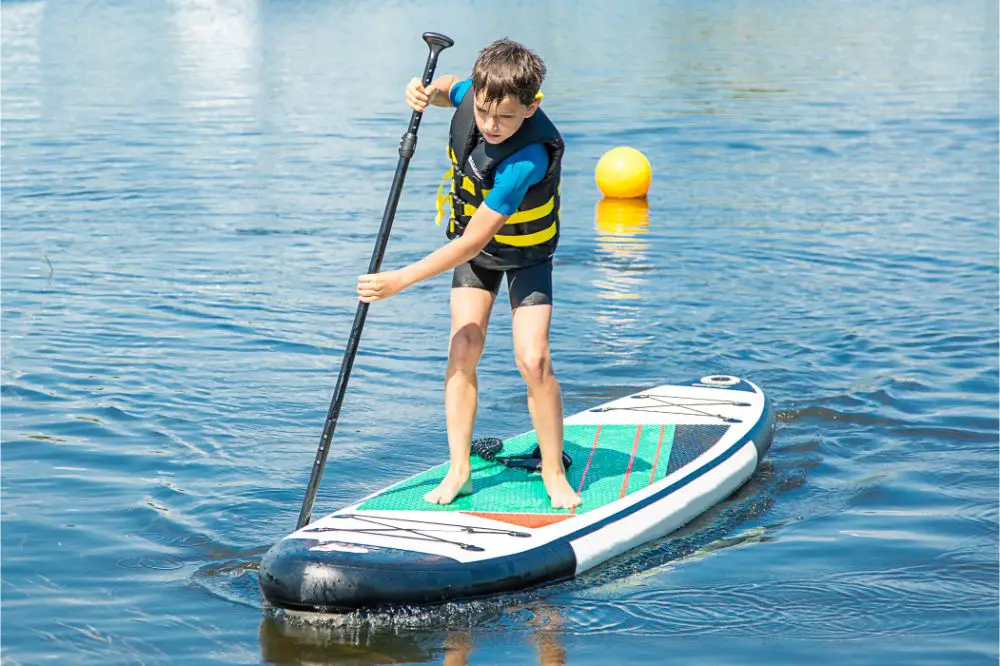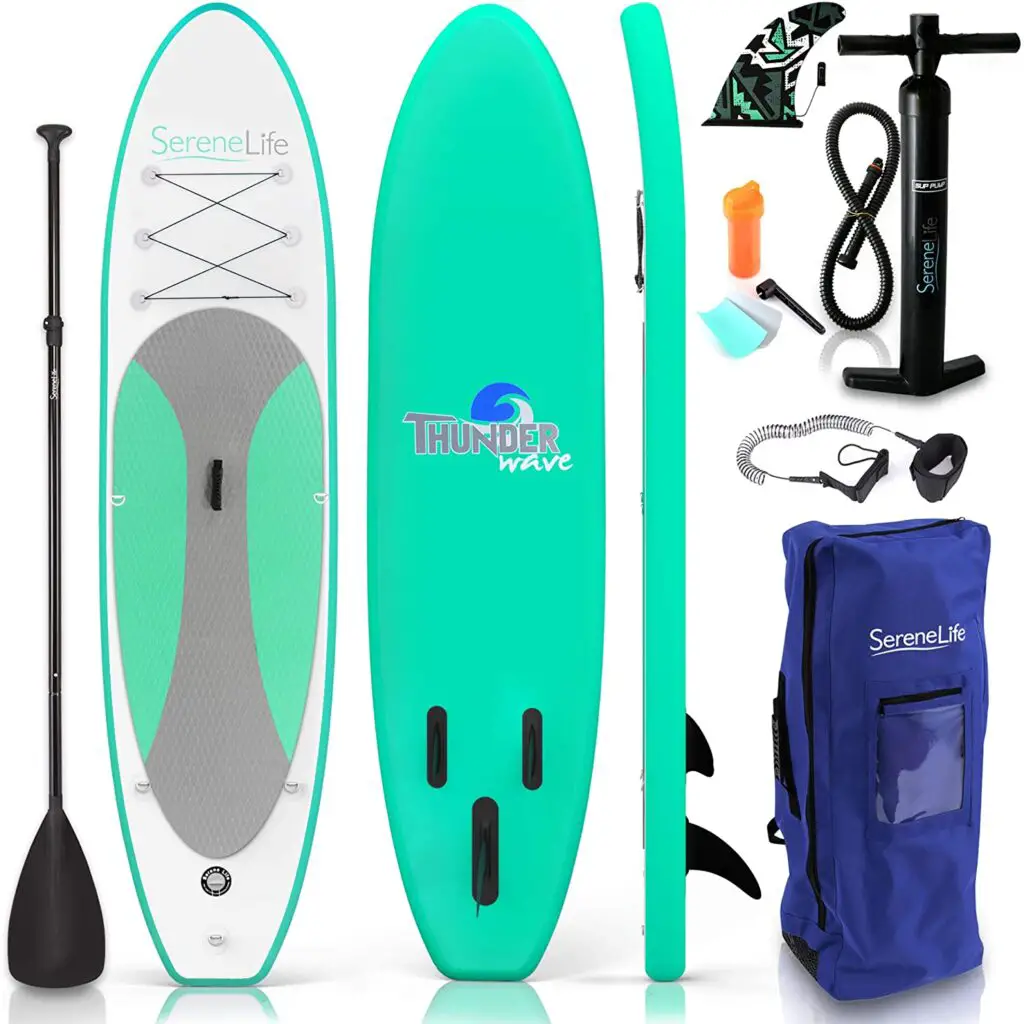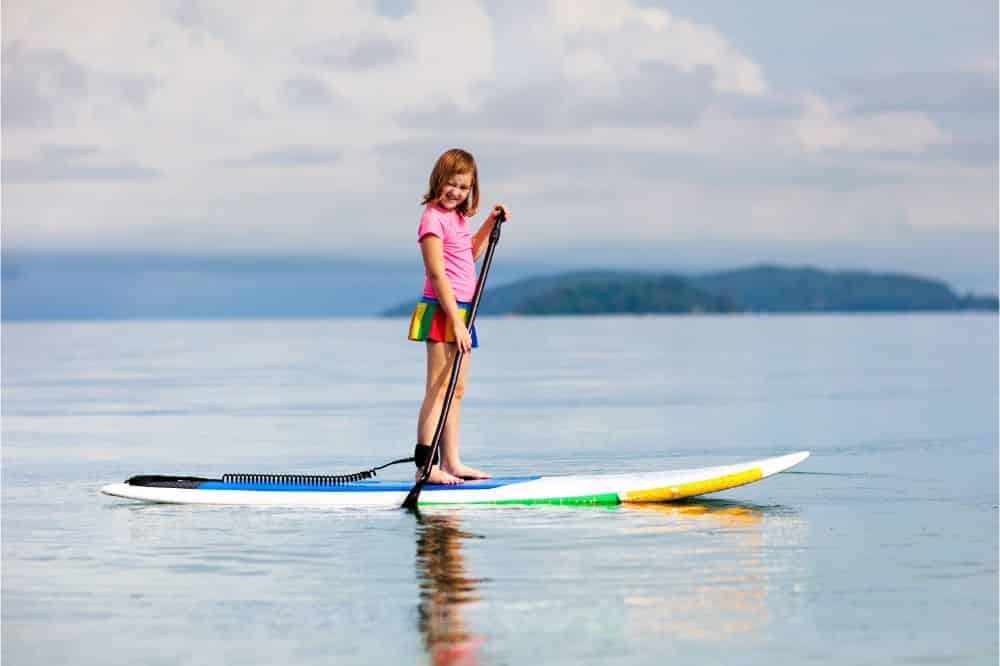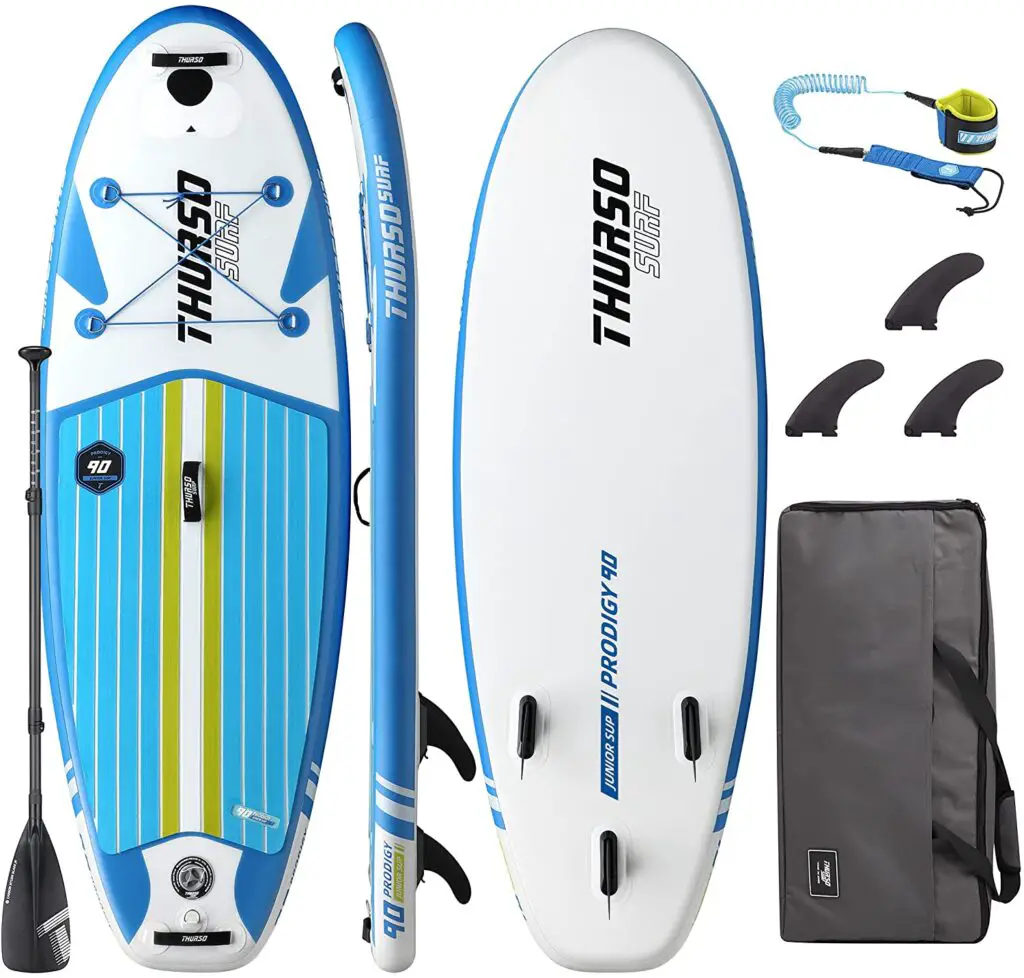We all want what is best for our kids.
Exercise is essential for their health and wellbeing, and so is having fun. Paddleboarding is an excellent way for kids to have so much fun while exercising that they forget it’s an exercise.
Here we will look at kids paddleboards to see what they are all about and if it is something your child would enjoy doing over weekends, holidays, and in their spare time.

What are Kids Paddleboards?
Stand-up paddling is for everyone. It is a fun way to play on the water while doing a full-body workout.
But how do Kids Paddleboards actually differ from Paddleboards for adults?
Stand-up paddleboards for kids are usually a lot smaller than those for adults. The smaller size makes it easier for kids to carry them while outside the water and handle them on the water. These boards are the same as the ones used by adults, the only difference being the size and deck design.
Stand-up paddling has gained popularity in recent years, and these paddleboards come in different shapes and sizes. Here are some of the features you should look out for:
- Hull type.
The type of hull a SUP has determines its functionality in water. Stand-up paddleboards have two hulls: a planing hull and a displacement hull. A planing hull has a similar hull to a surfboard’s. It is flat and wide and great for children because it offers stability. A displacement hull is great for going long distances and is suitable for racing. - Length.
Stand-up paddleboards come in different sizes. Shorter ones are great for kids because they are easy to maneuver. - Width.
Watching out for the width of a board is essential, especially when the user is a beginner or a young child. Wider boards offer more stability and have more room too.
Take a look at our Buying Guide where we explain everything you need to know in more detail.
Types of SUP boards
Some types of SUP boards include:
- All-around SUP boards.
These stand-up paddleboards are ideal for beginners, kids and young adults. They are suitable for your first-time standing attempts. They are usually longer, broader, and thicker. The curves are moderate and the edges are soft. - Touring SUP boards.
These boards have a pointed nose and are longer than all-around stand-up paddleboards. They are suitable for kids which already have paddling experience using them on flat water such as ponds, lakes, and open oceans. Most paddlers enjoy leisure and “touring” paddling on flat water. - Surf SUP boards.
They are specifically designed for surfing with a paddle. They are usually shorter and have more curves than other paddleboard types. They have a narrower nose and tail too. - Race SUP boards.
They look like flatwater stand-up paddleboards. The only difference is that they are narrower. Their narrow design increases their speed.
Of course there are a some more SUP Board Types like Downwinder or Whitewater SUP Boards, but they are typically not that important for Stand Up Paddling with Kids. However, if you would like to get a more thorough overview of the different boards, have a look at out large SUP Board Overview.
Types of SUP boards based on their build.
- Inflatable SUP boards.
These are also called iSUPs. They are portable boards that are made of drop-stitched layers of PVC. iSUPs take up little space and are great to travel with when they are deflated and folded. They are sturdy and kid-friendly. - Hard SUP boards.
Hard stand-up paddleboards are also called epoxy boards, non-inflatable boards, and fiberglass boards. They are made from wood, plastic, kevlar, or fiberglass. They move faster than inflatable SUP boards, but they take more space and are less portable.
These SUP boards also come in sizes meant for kids. For junior paddlers, we recommend All-around inflatable SUP boards. However, kids with more SUP experience can use other board types if they need to.
Additional Equipment to consider
While stand-up paddleboards for kids are fun, being safe is extremely important. It is essential to have the accessories needed for a SUP to guarantee their safety. Remember: Kids under the age of twelve are required to always wear a life jacket when using a SUP board.
Besides a life jacket and a safety leash, other accessories you’ll need for SUP include of course a paddle, a SUP pump and probably things like a waterproof bag and the right clothes for your kid.
More information about the essential equipment for SUP can be found in our extensive SUP accessories overview and our SUP clothing guide!
Is Stand-up Paddleboarding Safe for Kids?
Kids worldwide are enjoying this great exercise and having loads of fun at it because paddleboarding is safe. If you value safety and take all the necessary precautions, SUPs are very safe for kids. To ensure the safety of your kids, parents should check a few boxes. Here are some safety precautions.
- Going with your kids is vital, especially if they are little kids. You should be able to keep your eye on them while they are having fun.
- Your kids should always have a life jacket. A personal floatation device, too, wouldn’t be amiss.
- Having a safety leash is equally essential.
- Have wind, cold, and sun protection with you. Here are the SUP clothes you should have.
- It is an added advantage if the kids are good swimmers – teach them the correct paddle techniques so they know how to handle the SUP in all situations on the water.
And most of all, it is essential to use the correct board size. The volume and size of the board depend on the user’s weight. The user’s experience level should also be considered when choosing a board.
| Rider Weight (lbs) | SUP Width (in) | SUP Length (ft) |
|---|---|---|
| < 90 | 20” – 30” | 7′ – 9′ |
| 90 – 125 | 30” – 32” | 9′ – 10’9” |
| 125 – 150 | 31” – 32” | 9’6” – 10’9” |
| 150 – 175 | 31” – 33” | 10’0” – 10’9” |
The values given in the table above relate to typical values. If you want to have an even more detailed size chart, which also takes the skill level of your child into account, check out our sizing guide.
At What Age Can Kids Start SUP or Paddleboarding?
Equipped with the proper safety gear, kids can start paddleboarding on their own from five years and above. The boards they are using must be the right size for them. Children less than five should paddle with you on your board. To accommodate them, you will want to choose a bigger and more stable board.
SUP isn’t just adventurous and fun. It also increases your health and fitness. It strengthens muscles and it’s excellent cardio training. At the same time, with stand-up paddleboarding, about 500 to 700 calories are burned per hour. SUP is also great for kids as it is much gentler on the joints, muscles, and tendons as no additional weights are used.
Is an Inflatable Board Feasible for Stand Up Paddling?
Inflatable paddleboards are feasible and ideal for kids. iSUPs are sturdy and in our opinion the best option for children. Their rubber fins ensure that children will not hurt themselves on sharp-edged fins, usually characteristic of rigid paddleboards.
iSUPs also cushion kids’ falls and are lightweight, easy to carry, and affordable. A quality iSUP may be used for several years with little or no problems. iSUPs are pretty portable, too, especially when deflated and folded up.
A Great Example of an Inflatable Stand Up Paddle Board

A great example of an iSUP board is the SereneLife inflatable paddleboard (The Thunder Wave Version).
Its design is simply ideal for kids. It has a stable deck with a width of 32″. The deck has a soft padded layer that is non-slip and quite comfortable, even for long rides.
The SereneLife inflatable paddleboard is lightweight and easy to carry.
It is made with quality materials and it is very durable and fast. It is also easy to inflate and deflate, making it even more suitable for kids.
The main issue is that the paddle is a little unbalanced and heavy for kids, but one can correct this issue by getting a new, suitable paddle if necessary.
You can find selection of some of the best SUP Boards for Kids, in which we present you all the major pros and cons of different boards and why those are relevant for a Kids SUP in here:


